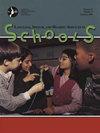"It's a Lot of Collaboration": Related Service Providers Supporting Literacy Instruction for Learners Who Use Augmentative and Alternative Communication.
IF 2.9
3区 医学
Q1 AUDIOLOGY & SPEECH-LANGUAGE PATHOLOGY
Language Speech and Hearing Services in Schools
Pub Date : 2025-07-10
DOI:10.1044/2025_lshss-24-00034
引用次数: 0
Abstract
PURPOSE Collaborative teaming has been found to be one of the most critical components in maximizing student outcomes in individuals who use augmentative and alternative communication (AAC). This study aimed to understand roles, barriers, and facilitators of related service providers when working on and collaborating in literacy instruction with learners who use AAC to maximize literacy outcomes. METHOD This study used an exploratory-descriptive qualitative design based on an in-person focus group of related service providers (occupational therapists, physical therapists, and speech-language pathologists) who all contribute to the development and implementation of literacy goals for students who use AAC. Qualitative analysis methods were used to transcribe and code the data thematically. RESULTS After analysis, four themes and nine subthemes were identified by the research team. Results highlight considerations including positioning and access, coaching, direct instruction, defined roles, common goals, and collaboration. Although the qualitative study captures the perspectives of members of a single school team, the findings help to support future research directions and implementation facilitators. CONCLUSIONS There is limited research that documents the various roles of related service providers when considering literacy adaptations and implementation (e.g., positioning needs to access literacy materials, the consistency of instruction, and increasing time in instruction). Collaborative teaming and goal planning among related service providers can potentially maximize literacy instruction for learners who use AAC.“这是大量的合作”:相关服务提供商支持识字教学的学习者谁使用增强和替代交流。
研究发现,协作团队是使用增强型和替代型沟通(AAC)的个体最大限度提高学生成绩的最关键因素之一。本研究旨在了解相关服务提供者在与使用AAC的学习者进行读写教学和合作时的角色、障碍和促进因素,以最大限度地提高读写效果。方法本研究采用探索性描述性定性设计,对相关服务提供者(职业治疗师、物理治疗师和语言病理学家)进行面对面的焦点小组调查,这些服务提供者都对使用AAC的学生的读写目标的制定和实施做出了贡献。采用定性分析方法对数据进行主题转录和编码。结果经过分析,研究小组确定了4个主题和9个副主题。结果突出了考虑因素,包括定位和访问、指导、直接指导、定义的角色、共同目标和协作。虽然定性研究捕获了单个学校团队成员的观点,但研究结果有助于支持未来的研究方向和实施促进者。结论:在考虑扫盲适应和实施时,相关服务提供者的各种角色(例如,获取扫盲材料的定位需求、教学的一致性和增加教学时间)的研究有限。相关服务提供者之间的合作团队和目标规划可以潜在地最大限度地提高使用AAC的学习者的识字教学。
本文章由计算机程序翻译,如有差异,请以英文原文为准。
求助全文
约1分钟内获得全文
求助全文
来源期刊

Language Speech and Hearing Services in Schools
Social Sciences-Linguistics and Language
CiteScore
4.40
自引率
12.50%
发文量
165
期刊介绍:
Mission: LSHSS publishes peer-reviewed research and other scholarly articles pertaining to the practice of audiology and speech-language pathology in the schools, focusing on children and adolescents. The journal is an international outlet for clinical research and is designed to promote development and analysis of approaches concerning the delivery of services to the school-aged population. LSHSS seeks to advance evidence-based practice by disseminating the results of new studies as well as providing a forum for critical reviews and meta-analyses of previously published work.
Scope: The broad field of audiology and speech-language pathology as practiced in schools, including aural rehabilitation; augmentative and alternative communication; childhood apraxia of speech; classroom acoustics; cognitive impairment; craniofacial disorders; fluency disorders; hearing-assistive technology; language disorders; literacy disorders including reading, writing, and spelling; motor speech disorders; speech sound disorders; swallowing, dysphagia, and feeding disorders; voice disorders.
 求助内容:
求助内容: 应助结果提醒方式:
应助结果提醒方式:


